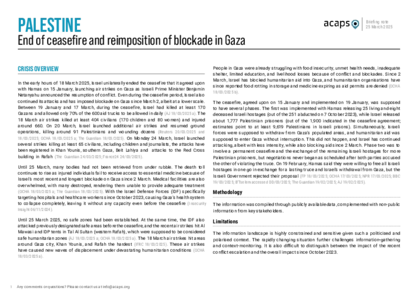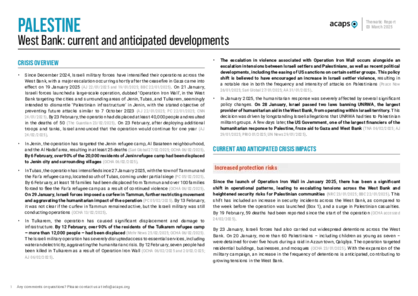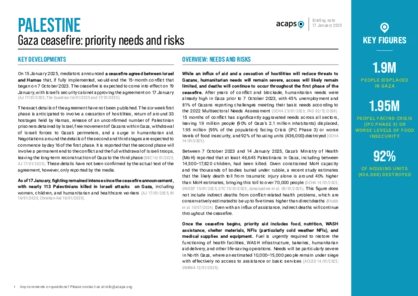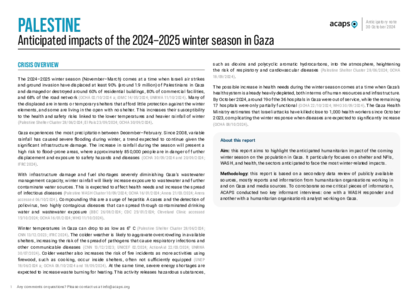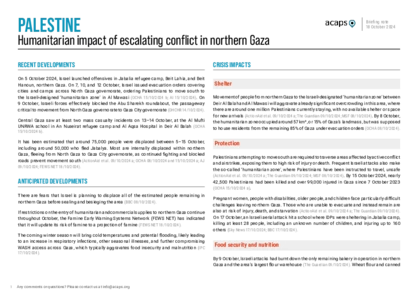Latest updates on country situation
30 July 2025
Despite the humanitarian pauses since 27 July 2025 in Al Mawasi, Deir Al Balah, and Gaza city, aid delivery through border crossings and airdrops is still limited and insufficient to cover needs. The entire population continues to be food-insecure, facing Crisis (IPC Phase 3) levels or worse. The situation in Gaza is described as the worst-case scenario of Famine (IPC Phase 5), driven by conflict, the Israeli blockade, and continuous displacement. By 29 July, there had been 147 reported deaths from starvation and malnutrition since 7 October 2023. (AP 28/07/2025, IPC 29/07/2025, AJ 29/07/2025)
23 July 2025
Because of the Israeli blockade on humanitarian aid since 2 March 2025, food and water supplies in Gaza have been nearly exhausted, resulting in widespread malnutrition and starvation. The entire population remains at Crisis (IPC Phase 3) or worse food insecurity levels; at least 22% face Catastrophe (IPC Phase 5) conditions. Between 20–22 July, approximately 21 children died from malnutrition. Many other children and adults arrive at hospitals severely weakened or collapse in the streets from hunger. Doctors, aid workers, and journalists are increasingly unable to operate given extreme exhaustion. Insecurity highly restricts access to the limited food available. When Israeli forces grant UN aid convoys entry, starving people rush towards the trucks, seeing the Israeli forces open fire on civilians and aid being looted before reaching distribution centres. In one such instance, nearly 80 people were killed after a WFP aid convoy entered Gaza on 20 July. (IPC 12/05/2025, WFP 21/07/2025, CBS 22/07/2025)
16 July 2025
Insecurity and fuel shortages have severely affected water distribution in Gaza, with only 40% of drinking water facilities operational by July 2025. This has led to a significant decrease in water production, which has fallen below half of March levels. Families are forced to use unsafe water sources, exposing them to waterborne diseases, including cholera, diarrhoea, hepatitis, and dysentery. (IRC 11/07/2025, STC 09/07/2025)
09 July 2025
Settler violence continues to slowly displace Palestinians in the West Bank. Between 2–4 July, armed settlers in an outpost established in the central Jordan Valley harassed the Palestinian community of Arab Al Ka’abneh by stealing about 60 sheep, occupying homes, and vandalising property. As a result, 26 families were displaced from the area. Their immediate needs are likely to include shelter, food, and NFIs. (OHCHR 04/07/2025, SABA 04/07/2025, AJ 07/07/2025)
09 July 2025
By 3 July, Gaza’s health system continued to face a near collapse caused by fuel shortages since 2 March. Hospitals, including Al Shifa, have reduced operations, cutting dialysis and suspending oxygen production. Nearly all public hospitals are damaged or non-operational, and the remaining facilities are overwhelmed, lacking fuel and medical supplies, resulting in high needs for healthcare services. (ICRC 02/07/2025, The New Arab 03/07/2025)
25 June 2025
Access to humanitarian aid at the newly established US- and Israel-backed Gaza Humanitarian Foundation distribution centres in southern Gaza continues to be highly challenging. Between 27 May and 23 June 2025, violence killed at least 467 people and injured 3,602 while en route to or at the aid sites, indicating extremely restricted access for Gazans to aid, especially food. (ACLED 20/06/2025, UN 18/06/2025, Al Mamlaka TV 23/06/2025)
25 June 2025
Since hostilities escalated between Israel and Iran on 13 June 2025, Israeli forces have imposed a strict lockdown on the West Bank, with up to 800 iron gates, concrete barriers, and roadblocks limiting movement in areas of Hebron, the Jordan Valley, Nablus, Qalqilya, and Ramallah. Livelihoods, medical care access, and aid delivery are disrupted. The lockdown is also preventing farmers from transporting their harvest to markets, forcing them to destroy the harvest instead and leading to income loss and reduced food access. Shortages in medical supplies, such as anaesthesia, and the cancellation of critical surgeries are reported, especially in hospitals in the south, including Hebron. Checkpoints and roadblocks are also forcing patients, including the critically ill, to walk long distances, risking being shot or denied passage. Insecurity at checkpoints and from Iranian air strikes is also restricting aid workers’ movement and aid delivery. (Anera 20/06/2025, MSF 23/06/2025, OCHA 18/06/2025)
current crises
in
Palestine
These crises have been identified through the INFORM Severity Index, a tool for measuring and comparing the severity of humanitarian crises globally.
PSE003 - Conflict in the West Bank
Last updated 22/07/2025
Drivers
Conflict/ Violence
Crisis level
Country
Severity level
3.6 High
Access constraints
5.0
PSE004 - Conflict in Gaza
Last updated 22/07/2025
Drivers
Conflict/ Violence
Crisis level
Country
Severity level
4.2 Very High
Access constraints
5.0
PSE002 - Multiple crises
Last updated 22/07/2025
Drivers
Conflict/ Violence
Crisis level
Country
Severity level
4.4 Very High
Access constraints
5.0
Analysis products
on
Palestine
25 March 2025
Palestine: end of ceasefire and reimposition of blockade in Gaza
DOCUMENT / PDF / 363 KB
On the evening of 17 March 2025, Israel unilaterally ended the ceasefire that it agreed upon with Hamas on 15 January, launching air strikes on Gaza. During the ceasefire, Israel had killed at least 170 Gazans and allowed only 70% of the 600 aid trucks to be allowed in daily. The 17 March air strikes killed at least 404 civilians and injured around 660.
Attached resources
03 March 2025
Palestine: current and anticipated developments in West Bank
DOCUMENT / PDF / 759 KB
Since December 2024, Israeli military forces have intensified their operations across the West Bank, with a major escalation occurring shortly after the ceasefire in Gaza came into effect on 19 January 2025
17 January 2025
Gaza ceasefire: priority needs & risks
DOCUMENT / PDF / 216 KB
On 15 January 2025, mediators announced a ceasefire agreed between Israel and Hamas that would end the conflict that began on 7 October 2023. While an influx of aid and a cessation of hostilities will reduce threats to Gazans, humanitarian needs will remain severe, access will likely remain limited, and deaths will continue to occur throughout the first phase of the ceasefire.
30 October 2024
Palestine: Anticipated impacts of the 2024−2025 winter season in Gaza
DOCUMENT / PDF / 2 MB
This report aims to highlight the anticipated humanitarian impact of the coming winter season on the population in Gaza. It particularly focuses on shelter and NFIs, WASH, and health, the sectors anticipated to face the most winter-related impacts.
Attached resources
18 October 2024
Palestine: Humanitarian impact of escalating conflict in northern Gaza
DOCUMENT / PDF / 143 KB
On 5 October 2024, Israel launched offensives in northern Gaza. It has been estimated that around 75,000 people were displaced between 5–15 October. Most are internally displaced within northern Gaza, fleeing from North Gaza to Gaza City governorate, as continued fighting and blocked roads prevent movement to south.


